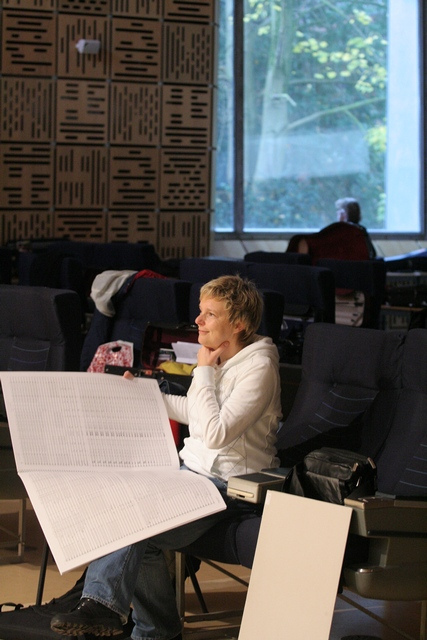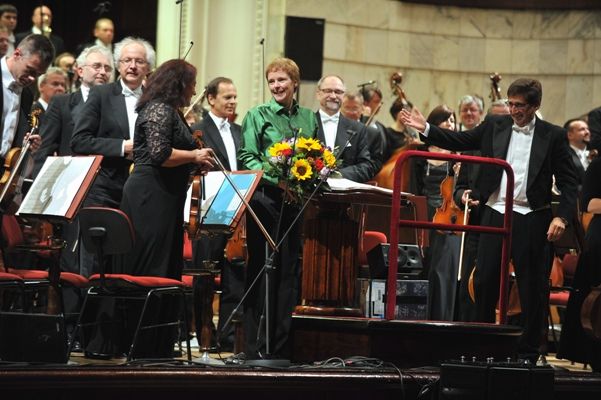contents
1. summary
2. listen
3. programme notes
4. details
5. performances
summary
Rozalie Hirs’s Roseherte (“Rosedeer”/“Rosehart”) is an orchestral poem inspired by a mythical creature whose name intertwines the rose, the heart, and the deer. The music unfolds from pairs of dominant sevenths, transformed through transposition and ring modulation into radiant, prismatic harmonies. Alongside the 90-piece orchestra, live-triggered electronics surround the music in a shimmering halo. Acclaimed at its premiere for its vibrant play of colour and organic flow, Roseherte was nominated for the Toonzetters Prize in 2008.
listen
programme notes
Roseherte (“Rosedeer” or “Rosehart”) takes its Middle Dutch title from a mythical creature imagined by composer-poet Rozalie Hirs, said to dwell deep within the human heart. The name playfully intertwines myth, etymology, and identity: her first name evokes the rose, while the Middle Dutch herte (Middle English hert; English hart) means both heart and deer, resonating with her family name, Hirs (from the German Hirsch, “deer”).
In this orchestral poem, the rosehart is awakened on a journey through rain and sunlight, beneath rainbows and drifting zeppelins, singing of clouds and time, accompanied by the hum of high-tension wires.
The score is woven from pairs of dominant seventh chords whose roots stand a perfect fifth apart, producing harmonies at once radiant and restless. Transposed, these pairs evoke overlapping harmonic series. Through ring modulation, each chord is refracted through the spectrum of its sibling, yielding prismatic sonorities that shimmer “in the light of each other.” Every frequency was calculated, then refined by hand and ear into orchestral notation. With these same frequencies, Hirs also synthesised 150 electronic sounds, realised in Csound. In performance, a musician triggers them live through stereo speakers on stage. The electronics create an “aural halo” around the 90-piece orchestra — sometimes blending seamlessly, at other times opening new acoustic perspectives.
Upon its premiere, Roseherte was acclaimed for its vivid, breathing sound world. Thea Derks (Radio 4) praised its “enchanting play of sound colour, transforming the orchestra into one breathing, pulsating entity, in which recurring motives received an ever-changing illumination.” Jochem Valkenburg (NRC) described “a refined play of sound colour, followed by a striking passage where sound vortexes expand around a more melodic core, like circles on water.” Frits van der Waa (Volkskrant) highlighted the “subtle electronic sound mixtures accentuating the orchestra in an appealing science-fiction manner.”
Roseherte was nominated for the prestigious Toonzetters Prize as one of the ten finest new works of 2008.
details
commission
Roseherte was commissioned by Nederlandse Muziekdagen (artistic director: Micha Hamel) and the Netherlands Radio Philharmonic Orchestra.
duration
15′ ca.
instrumentation (2008, version for symphony orchestra: 91 players)
3 flutes (flutes 2: also piccolo)
3 oboes (oboe 3: also cor anglais)
3 clarinets (clarinet 3: also bass clarinet)
3 bassoons (bassoon 3: also contrabassoon)
4 French horns
3 trumpets
2 tenor trombones
1 bass trombone
tuba
timpani (1 player)
4 percussionists: crotales (bowed and hit), 3 glockenspiels, 4 thai gongs, tubular bells (twee octaves: one standaard and one low set), vibraphone (4 octaves), marimba, 12 bell plates (or bell plate sampler, to be obtained through the composer), 3 cymbals (high, medium, low; to bow with string bows), 2 sand paper blocks, bass drum
celesta (1 player)
piano
harp
midi keyboard & laptop for electronic sounds (1 player)
16 violins I
14 violins II
12 violas
10 cellos
8 double basses
instrumentation (2014; revised version for orchestra: 42 players)
2 flutes (flute 2: also piccolo)
2 oboes (oboe 2: also cor anglais)
2 clarinets (clarinet 2: also bass clarinet)
2 bassoons (bassoon 2: also contrabassoon)
2 French horns
2 trumpets
1 tenor trombones
1 bass trombone
tuba
2 percussionists: crotales (bowed and hit), glockenspiels, thai gongs, tubular bells, vibraphone (4 octaves), marimba, 3 cymbals (high, medium, low; to bow with string bows), 2 sand paper blocks, bass drum
piano
harp
midi keyboard & laptop for electronic sounds (1 player)
6 violins I
6 violins II
4 violas
4 cellos
2 double basses
further technical requirements
1.) Logic software, to be installed on the above mentioned laptop
2.) The ‘Hirstotaal’ sampler, to be obtained through Deuss Music.
This sampler with 150 electronic sounds was programmed by sound engineer and designer Jan Panis. The sounds were synthesized by Rozalie Hirs with technical assistance by Casper Schipper. The sound synthesis was done with the help of Csound software. Together the electronic sounds become a flexible soundtrack, that is used both as a reference for the orchestra with respect to the microtonal tuning as well as shaping a sound space within which the orchestral sound can evolve.
3.) Amplifier and mixer in the concert hall
4.) Stereo loudspeakers, to be placed next to or near the orchestra on the podium
publisher
The score of Roseherte (2008) can be purchased through its publisher Deuss Music.
performances
6 November 2014 (version for orchestra: 42 players), 19:00, November Music, Verkadefabriek (Grote Zaal), Den Bosch, The Netherlands – Philharmonie Zuidnederland, Bas Wiegers (conductor)
21 September 2012 (version for symphony orchestra: 90 players), 19:30, Fifty-fifth International Festival of Contemporary Music Warsaw Autumn, Warsaw Philharmonic Hall, Warsaw, Poland – Warsaw Philharmonic Orchestra, Pascal Rophé (conductor)
8 November 2008 (version for symphony orchestra: 90 players), 20:15, Nederlandse Muziekdagen: Oer, Muziekgebouw aan’t IJ, Amsterdam, The Netherlands – Radio Philharmonic Orchestra, Micha Hamel (conductor) – world premiere
Photograph: Rozalie Hirs on stage after the performance of Roseherte by the Warsaw Philharmonic at Warsaw Autumn (photo ©2012 Jan Bogacz)

